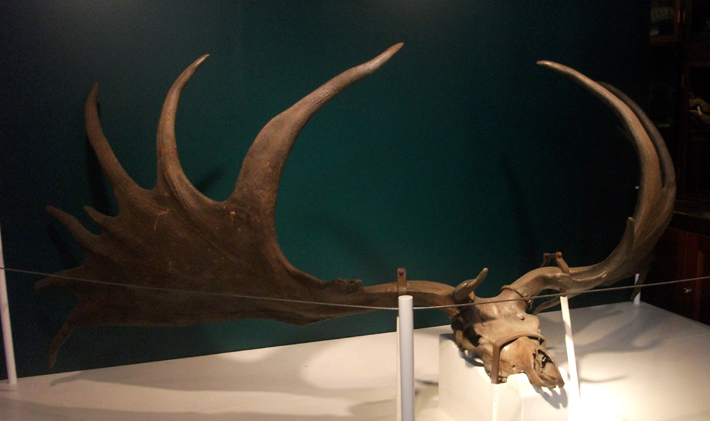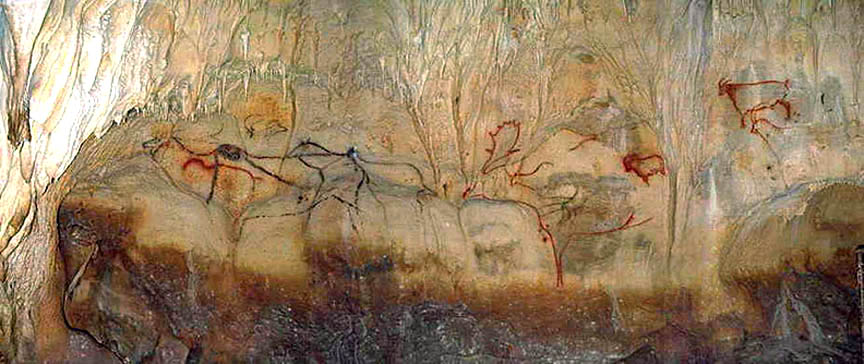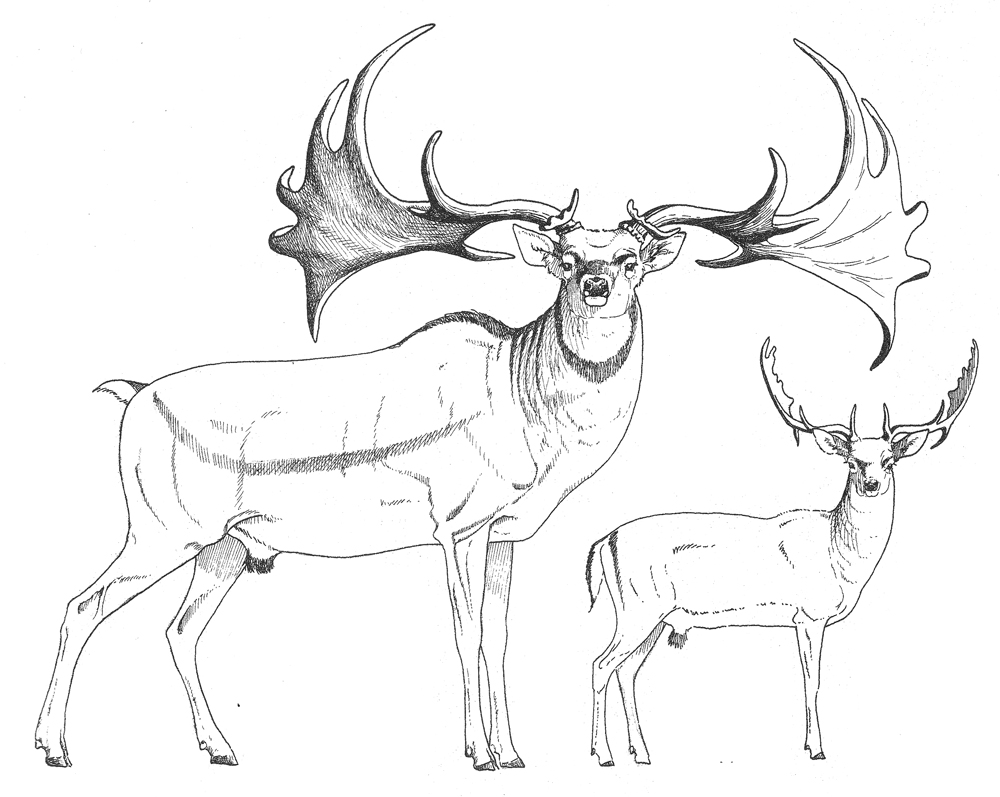Eurasian Pleistocene megafauna are among the most familiar and oft-depicted of prehistoric animals. And among these grand, charismatic and imposing animals is the giant deer Megaloceros giganteus, an Ice Age giant that occurred from Ireland and Iberia in the west to southern Siberia in the east. It persisted beyond the end of the Pleistocene, surviving into the Early Holocene on the Isle of Man (Gonzalez et al. 2000) and western Siberia (Stuart et al. 2004)*. It is often erroneously termed the Irish elk, though it certainly wasn’t restricted to Ireland, nor should it really be termed an ‘elk’ (ugh… we’ll avoid that whole hornet’s nest for the time being). It’s been termed the Shelk by others [UPDATE: but see comments!!]. It could be 1.8 m tall at the shoulder and weigh somewhere around 600 kg, the antlers spanning 3.5 m in cases and weighing 35-45 kg (Geist 1999).
Caption: a very conventional, traditional image of Megaloceros giganteus: it's depicted looking like a giant red deer, basically. Males and females are not that different in size, but males are often shown as maned. Most interest in this deer has, of course, concerned the spectacularly antlered males. This image is from Hutchinson's Extinct Monsters (published several times over the 1890s). Image: Hutchinson (1892).
* In a previous edit of this article, I said that M. giganteus also survived into the Holocene in central Europe, as demonstrated by Immel et al. (2015). I missed the fact that this research concerns specimens dated to the Upper Pleistocene, not the Holocene. Furthermore, I’ve also been told that the Isle of Man data proved incorrectly dated. Am chasing confirmation on this.
While big, M. giganteus was not the biggest deer ever, since it seems that the extinct, moose-like Cervalces latifrons was even bigger. I promise to talk more about that species when I get round to discussing moose and kin at length. And while the antlers of M. giganteus were obviously very big, they weren’t especially big relative to its body size: proportionally, they were about similar in size to those of large Fallow deer Dama dama, and well exceeded in proportional size by the antlers of reindeer and caribou.
Caption: a fine Megaloceros skull on show at London's Grant Museum. I seem to recall hearing or reading - possibly in one of Stephen J. Gould's papers - that this is one of the largest specimens in existence. Image: Darren Naish.
I should add that M. giganteus was not the only Megaloceros species. Several others are known, differing in how palmate or slender and branching their antlers were, and not all were as large as M. giganteus (some were island-dwelling dwarves). There are other genera within this deer lineage (Megacerini) as well. Also of relevance to our discussion here is the position of these deer within the cervid family tree. Some experts have argued that megacerines are close to deer like the Red deer Cervus elaphus (Kuehn et al. 2005), while others point to genetic and morphological data indicating a close relationship with the Fallow deer Dama dama (Lister et al. 2005, Hughes et al. 2006, Immel et al. 2015, Mennecart et al. 2017). I have a definite preference for the latter idea, and right now it's a far better supported relationship than the alternative.
Caption: male M. giganteus skulls in the collections of the National Museum of Ireland, Dublin, examined in 2008. Yes, there is indeed a preponderance of males. Image: Darren Naish.
Like most European people who’ve been lucky enough to visit museums and other such institutions, I’ve seen Megaloceros specimens on a great many occasions – there are a many of them on display. I’ve also seen and handled a reasonable number of the Irish bog specimens during time spent in Dublin. There does appear to be a preponderance of big, mature males. Maybe this reflects collecting bias (in that people were more inclined to extract the skulls and skeletons of big, prominently antlered males), but it also seems to be a valid biological signal: it has been argued that the calcium-hungry males were likely attracted to calcium-rich plants like willow at the edges of lakes and ponds, and were thus more prone to drowning, miring or falling through ice in such places than females (Geist 1999). Oh, we also know that male mammals across many species are more inclined to take stupid risks, be reckless, and even display deliberate bravado more than their female counterparts.
Here we come to the main reason for this article: what, exactly, did M. giganteus look like when alive? I’ve surely mentioned this topic on several occasions over the years here; I’m pretty sure I threatened to write about it after producing similar articles on the life appearance of the Woolly rhino and Ice Age horses. M. giganteus has been illustrated a great many times in works on prehistoric life, and the vast majority of reconstructions show it a near-monotone dark brown or reddish-brown. It’s very often depicted with a shaggy neck mane. In short, it’s usually made to look like a big, shaggy Red deer, and the tradition whereby this is done – it extends back to Zdenek Burian, Charles Knight and other founding palaeoartists – seems to me to be another of those palaeoart memes I’ve written about before. I’ve taken to calling this one the ‘Monarch of the Glen’ meme (see my palaeoart meme talk here). I will add here that we're generally talking about males of the species (since people mostly want to see depictions of specimens with those awesome antlers), though virtually all that I say below applies to females too.
Alas, this view of M. giganteus is almost certainly very wrong. Why do I say this?
Caption: note the many obvious external features of this male Fallow deer: a throat bulge corresponding with the larynx - an 'Adam's apple' - is obvious, and this is a boldly marked deer overall, with prominent spots (including some that have coalesced into stripes), a white rump patch, and pale ventral regions. If megacerines are close kin of Dama deer, we might predict a similar ancestral condition for Megaloceros and its relatives. Image: Dave Hone.
Firstly, if we look at the colours and patterns present across cervine deer as a whole, we see quite a bit of variation and no strong and obvious reason why a ‘Red deer look’ should be favoured. Secondly, we have that data indicating that M. giganteus is phylogenetically closer to Dama deer than to Cervus, in which case we would predict that it descended from ancestors with prominent spotting, pale flank stripes, and dark markings on the tail, all features typical of modern Dama populations. If the ‘Dama hypothesis’ is correct, there is again no reason to favour a ‘Red deer look’ for M. giganteus. Thirdly, body size, limb proportions, antler size and habitat choice all indicate that M. giganteus was an open-country (Clutton-Brock et al. 1980), cursorial specialist, and in fact the most cursorial of all deer (Geist 1999). Cursorial, open-country artiodactyls are often pale, with large white areas across the rump, legs and belly (examples include addax, some Arctic caribou and some argali). Again, no reason here to suspect that ‘Red deer look’.
And... fourthly, we have direct eyewitness data on the life appearance of this animal. Members of our own species saw it in life and drew it, seemingly to a very high degree of accuracy. What did they show?
Caption: the famous panel at Cougnac, southwest France, showing M. giganteus males and females. This part of the cave is also interesting in depicting a short-horned bovid (at upper right) sometimes interpreted as a tahr. There are also ibex here too. I'm uncertain of the exact origin of the photo shown here: I took it from Fabio Manucci's blog Agathaumus. Numerous additional photos of the same cave can be seen at Don's Maps.
Virtually all cave art depicting M. giganteus shows a rounded, tall shoulder hump that’s sometimes shown as if it had a crest of raised hairs. Guthrie (2005) termed this a ‘hackle tuft’. There’s no obvious indication from the skeleton that a hump like this was present (indeed, fatty humps in mammals very often do not have an underlying skeletal correlate), so this is a neat thing that we wouldn’t know from skeletons alone. A protruding lump on the throat that seems to correspond to the larynx is also shown in images at Lascaux, Roucadour and elsewhere (Guthrie 2005). This feature is very reminiscent of Fallow deer.
Caption: cave art depicting M. giganteus is not all that numerous (most ancient depictions of deer are of reindeer or red deer), but what does exist shows several details worthy of note, here emphasised in illustrations produced by R. Dale Guthrie. The shoulder hump is a consistent feature. Image: Guthrie (2005).
Some of the art provides information on pigmentation. A collar-like band is depicted encircling the neck in images from Chauvet and Cougnac, the shoulder hump is shown as being dark in images from Cougnac and elsewhere (Lister 1994), and some of the Chauvet and Roucadour images show a dark diagonal line that extends across the side of the body from the shoulder to the edge of the groin, and sometimes across the leg as far as the hock (ankle). An especially detailed image at Cougnac, partially illustrated on a stalactite, shows what looks like a dark vertical stripe descending from the shoulder hump and forming a division between the deep neck and the rest of the body. The same image also shows dark near-vertical markings around what might be a pale rump patch (Guthrie 2005).
Caption: other people have taken the same evidence I've discussed here and produced very similar reconstructions. This piece - which I hadn't seen until after producing my own illustrations (on which, see below) - is by Pavel Riha. Image: Pavel Riha, CC BY-SA 3.0.
If these details have been interpreted correctly, M. giganteus was boldly marked, with obvious dark striping across its neck, shoulders and torso, and on its rump too. R. Dale Guthrie proposed that the vertical shoulder stripe formed a boundary between a near-white neck and head region and the rest of the body, with the latter being pale just posterior to the stripe but darker across the legs, rump and flank (Guthrie 2005). I’m not absolutely convinced by the evidence from cave art for a near-white neck and head or for a white rump patch but these things are consistent with what I said above about the open-country lifestyle and cursoriality of this deer. Geist (1999) was a fan of this idea, and his reconstruction of M. giganteus – shown here – is meant to show the animal as being quite pale apart from its obvious striping and other dark markings.
Caption: M. giganteus as reconstructed by Valerius Geist, and shown to scale with the extant Dama dama. Geist was (and presumably is) a strong advocate of the idea that megacerines (yes: megacerines, not 'megalocerines') are part of the same lineage as Dama. Image: Geist (1999).
Guthrie produced a very striking illustration depicting all of these details, but his drawing, as reproduced in his book (Guthrie 2005), is less than 4 cm long. Here it is (below), but note that I’ve produced a larger illustration here (scroll down) that shows the same details.
Caption: at left, the best of the M. giganteus images from Cougnac in France, as re-drawn by Guthrie (2005). At right, Guthrie's reconstruction of the animal's life appearance. Image: Guthrie (2005).
And that just about brings us to a close. Over the years, I’ve been perpetually dismayed by the fact that most people illustrating this animal aren’t aware of the information I’ve discussed here – I mean, we have direct eyewitness data that should be pretty much the first thing we take account of when reconstructing this animal. Alas, the usual problem here is that the people who provide advice on reconstructions of fossil animals to artists are virtually never that interested in or knowledgeable about the life appearance of the animals concerned (sorry, palaeontologists). That’s an unfair generalisation though, and there are of course exceptions. Indeed, I should note that accurate, informed reconstructions of M. giganteus have appeared here and there over the years: the Megaloceros depicted in the Impossible Pictures TV series Walking With Beasts, for example, includes most of the features I’ve discussed here and obviously benefitted from the input of an informed consultant.
Anyway, my hope for the article you’re reading now is that it will inspire the current generation of palaeoartists to start illustrating Megaloceros in a way that’s more in accord with the data from prehistoric art, all of which has been out there in the literature for years now (Lister 1994, Guthrie 2005).
I have further articles of this sort in mind and hope to get them published here eventually. On that note, here’s your reminder that I rely on your kind support at patreon, and that the more such support I receive, the more time and effort I can devote to Tet Zoo, and to my various book projects.
For previous Tet Zoo articles on Pleistocene megafauna, see...
Tet Zoo picture of the day # 3 (Elasmotherium), May 2007
The remarkable life appearance of the Woolly rhino, November 2013
Spots, Stripes and Spreading Hooves in the Horses of the Ice Age, February 2015
And for articles on deer, see...
Oh deer oh deer oh deer, October 2006
Deer oh deer, this joke gets worse every time I use it, November 2007
Britain: wildlife theme-park, December 2007
At the 56th SVPCA - hello Dublin! (Megaloceros), September 2008
The plasticity of deer, October 2008
Pouches, pockets and sacs in the heads, necks and chests of mammals, part IV: reindeer and a whole slew of others, October 2010
The seemingly endless weirdosity of the Milu, October 2011
South America's Many Remarkable Deer, November 2014
Confrontational behaviour and bipedality in deer, December 2014
Refs - -
Clutton-Brock, T. H., Albon, S. D. & Harvey, P. H. 1980. Antlers, body size and breeding group size in the Cervidae. Nature 285, 565-567.
Geist, V. 1999. Deer of the World. Swan Hill Press, Shrewsbury.
Gonzalez, S., Kitchener, A. C. & Lister, A. M. 2000. Survival of the Irish elk into the Holocene. Nature 405, 753-754.
Hughes, S., Hayden, Th. J., Douady, Ch. J., Tougard, Ch., Germonpré, M., Stuart, A., Lbova, L., Garden, R. F., Hänni, C. & Say, L. 2006. Molecular phylogeny of the extinct giant deer, Megaloceros giganteus. Molecular Phylogeny and Evolution 40, 285-291.
Hutchinson, H. N. 1892. Extinct Monsters, 2nd edition. London: Chapman & Hall.
Immel, A., Drucker, D. G., Bonazzi, M., Jahnke, T. K., Münzel, S. C., Schuenemann, V. J., Herbig, A., Kind, C.-J. & Krause, J. 2015. Mitochondrial genomes of giant deers suggest their late survival in Central Europe. Scientific Reports 5: 10853.
Kuehn, R., Ludt, C. J., Schroeder, W. & Rottmann, O. 2005. Molecular phylogeny of Megaloceros giganteus - the Giant deer or just a giant red deer? Zoological Science 22, 1031-1044.
Lister, A. M. 1994. The evolution of the giant deer, Megaloceros giganteus (Blumenbach). Zoological Journal of the Linnean Society 112, 65-100.
Lister, A. M., Edwards, C. J., Nock, D. A. W., Bunce, M., van Pijlen, I. A., Bradley, D. G., Thomas, M. G. & Barnes, I. 2005. The phylogenetic position of the ‘giant deer’ Megaloceros giganteus. Nature 438, 850-853.
Mennecart, B., deMiguel, D., Bibi, F., Rössner, G. E., Métais, G., Neenan, J. M., Wang, S., Schulz, G., Müller, B. & Costeur, L. 2017. Bony labyrinth morphology clarifies the origin and evolution of deer. Scientific Reports 7: 13176.
Stuart, A. J., Kosintsev, P. A., Higham, T. F. G. & Lister, A. M. 2004. Pleistocene to Holocene extinction dynamics in giant deer and woolly mammoth. Nature 431, 684-689.















